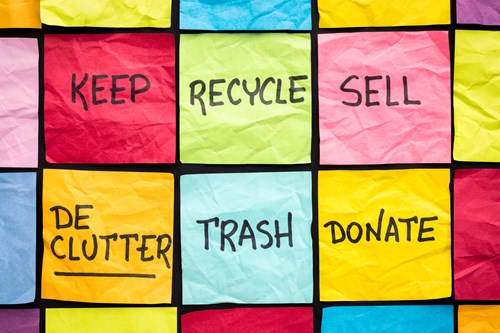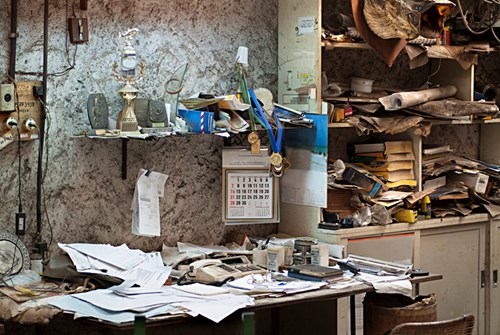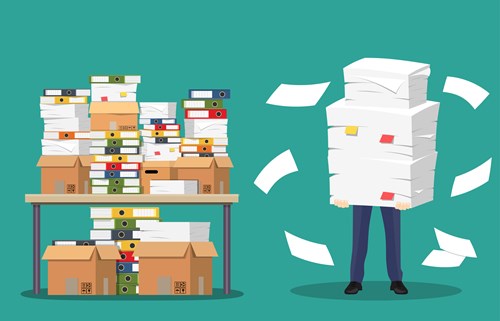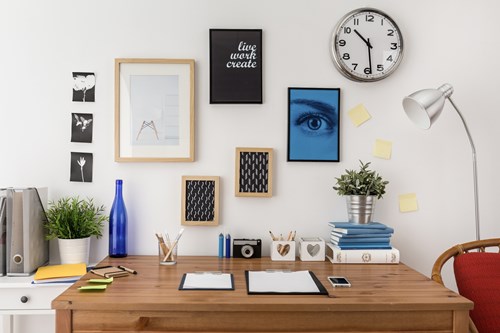Tidying my ELT mess with the KonMari Method™

We’ve welcomed in the new year and made resolutions to be better, healthier and more experimental. (If you haven’t made your new year resolutions, have a look at this post of mine for ideas.) But sometimes, just being in the same old environment can really get us down and make us lose track of all our well-intentioned plans.
Take myself for example. This year, I would really like to read more, engage in more stimulating debates and discussions, write more and learn more. But each time I walk into my study, I feel deflated. I’m confronted by piles of books, papers and magazines scattered everywhere and the information they hold seem to me as inaccessible as the mess before me. I have more bookshelves than anyone I know, yet they are so full nothing else can fit. Subsequently, new books, papers, magazines start to find their way to the desk, the chair, the floor … and I find myself doing my writing in the dining room, just so I can clear my head.
Over the holidays, a new TV series called Tidying Up with Marie Kondo popped up on my streaming service. Around the same time, my social media timelines started to be filled with friends posting tidying up and the KonMari Method™ – posts by friends who have not just watched her on TV but have read her book on tidying and decluttering, tried her ideas out and now swear by her method. Large numbers of people were suddenly waiting in line to sell and donate their old clothes and remove the clutter from their lives.
The newspapers have picked up on this new tidying and de-cluttering fad with articles dissecting every aspect of the programme popping up on the internet – discussing everything from the impact of dumping our clutter on the environment to the feminist message behind this tidying movement and the gendered expectations we inherently have of domestic chores.
Intrigued, I decided to try using her method to declutter my study and earn myself some thinking space.

If you haven’t seen the series or read her book, here’s the KonMari Method™ in a nutshell:
- Visualise your goal.
- Set a timeframe.
- Thank the house (or in my case the study) that you’ll be working on.
Thank it for providing you with a safe space. Marie Kondo sees tidying as part of being good to the house. - Sort by category, not location.
Marie Kondo has five categories which she recommends you sort in order: clothing, books, papers, komono (little things, i.e. miscellaneous items), items of sentimental value. Is it wrong for me to tweak her method a little by just doing my study? I figured that it’ll be as if I was tidying up my office space. - Put all the items of the category you’re sorting in one big pile.
This gives you a better idea of how much you’ve got. - Pick up each item, hold them in your hand and ask yourself if they spark joy.
This could be said to be the key to the KonMari Method™: identifying that feeling of excitement, joy and happiness when holding the item. If it doesn’t spark joy, thank it and put it in the ‘discard’ bag/box. If it does, put it in the ‘keep’ bag/box. - Designate a place for your items and store them.
Marie Kondo recommends storing items in such a way that you can see them easily. This would encourage you to use them.
Inspired, I decided to apply my version of the KonMari Method™ to my study. Deviating slightly from her method however, I decided to divide my ELT-related items into the following five categories: Books, Magazine & journals, Teaching tools and stationery, Papers (lesson plans, school documents, etc.), Decorative items and things of sentimental value. And I took some time out and proceeded to go through them.
Books
There were:
a) books that I have read and would like to keep as reference;
b) books that I have read and would not look at again;
c) books that I haven’t read but keep promising myself I will;
d) books that I haven’t read and really don’t think I will.
Why did I do this? Well, an article in the Guardian recently argued that the metric of ‘sparking joy’ is problematic when applied to books as books might not just give us pleasure and happiness but might be there to challenge and perturb us.
The Japanese word that Marie Kondo uses to express this is ‘Dokidoki suru’, an onomatopoeic word used to describe the fast beating of the heart. In essence, Marie Kondo is suggesting that the books we keep ought to make our hearts beat a little faster, whether through feeling excited or inspired, or through the enjoyment of having our thoughts provoked.
Remembering that I’m dealing with reference books and ELT books, the kind of joy they are likely to spark would be significantly different from the kind of joy a book like Who Moved My Cheese? or The Alchemist would bring. As a bit of an ELT nerd, joy to me (or this dokidoki feeling) is the inspiration I feel when I read parts of Pedagogy of the Oppressed, or the clarity I experience reading sections of Rod Ellis’s Second Language Acquisition, or those lightbulb moments that I experienced when I went through Scott Thornbury’s About Language during my DELTA some 12 years ago. For those books I haven’t read yet, I thought about the potential joy it might bring me, the knowledge I might receive, the inspiration I might feel, the thought processes it might trigger. And without overthinking things, I focused on how each book makes me feel, which in turned helped me determine which books to keep and which ones to get rid of.
Magazines and Journals
Here, there were:
a) articles I have read and perhaps enjoyed but will never need again;
b) articles I have read and will continue to refer to and use in my teacher training sessions;
c) articles that I have written and would like to keep as a record of my work;
d) articles that I have never read and intend to read;
e) articles that I have never read and probably won’t read.
Some of the articles e.g. the ETp articles, were available online, which meant that I didn't need to hold on to the physical copy. For those that weren’t online, I cut out the articles I wanted and stored them in individual clear pockets in folders.
I then used my ETp account to log on to My CPD to update it with the articles I have read to enable me to track the titles of the articles and my learning and development.

Teaching tools and stationery
Here, I had:
a) Tools I purchased for use in class e.g. Cuisenaire rods, mini whiteboards, story cubes, board games, etc.;
b) Things I had created for use in the classroom e.g. laminated flash cards, pretend monopoly money, games made from cutting out photocopiable materials, etc.;
c) Technology tools like flip cameras, USB sticks, SD cards, etc., some of which I no longer use;
d) Pens, pencils, markers, rubbers, paper clips, staplers, etc.
It was nice to thank the items that I decided to get rid of. It gave me a chance to remember the lovely ways I had been able to use them, and the students I used them with. In my tidying up, I found two boxes of flashcards that I had purchased from a language fair I attended straight after I did my CELTA (my first teaching qualification). There were sets to teach weather vocabulary, sets for basic food items, sets for prepositions of place, etc. I remember being really happy with myself when I first bought them, and would try and use them whenever I could. But the way I teach has moved on dramatically since and I knew that I wouldn’t be using them again. Perhaps it was time to pass them on to someone who might get that level of excitement from them as I once did.
Papers
This was probably one of the hardest categories for me. That was because it included:
a) Lesson plans (my own, my trainees’ and other colleagues’);
b) My handouts (I always have some leftover which I vow to use on the next course … and then I forget I have them);
c) Handouts from courses, talks and workshops I have attended;
d) Lesson material;
e) Official documents like syllabus, exam or course criteria, forms, templates, etc.;
f) My students’ homework or assignments that I have decided to keep (for sentimental reasons).
I had always been one to file away my papers in an organised fashion, labeling each folder meticulously and sometimes including a content page for when I needed to go back in search for something. But if I had to be honest, I very hardly go back to those folders for anything. So, taking Marie Kondo’s advice, I decided to be really brutal about my papers. Most official documents like exam criteria could be easily found online if I needed them again. Using an app like CamScanner on my phone, I took photos of the papers I really wanted to keep, and then converted them into pdf files. Then I got rid of the lot.
Decorative items and things of sentimental value
I thought I didn’t have many items in this category until I started putting them in a pile. I found …
a) Decorations, toys and knick-knacks I had accumulated over the years;
b) Gifts from my students and colleagues e.g. souvenirs from their countries;
c) Photos, some in albums, some in frames, and some just loosely slipped in between the pages of albums, books and folders.
Marie Kondo suggests that when decluttering items of sentimental value, we should focus on what to keep instead of what to throw away. And with the things we decide to keep, we should display them in a way that allows us to enjoy them, instead of hiding them away and forgetting about them. I slowly went through each and every item, asking myself the crucial question: Does it spark joy in me? Does it make my heart beat a little faster? And the items that I did choose to keep, I now proudly display them around my study.
Did you feel as inspired by Marie Kondo as I was? Do you also feel that you study/office space could do with a decluttering session? Please share your thoughts with me on Twitter @etprofessional or in the comments below!

This is not my study. This is the image I have in my mind as I laboriously tidy it up.


Comments
Write a Comment
Comment Submitted